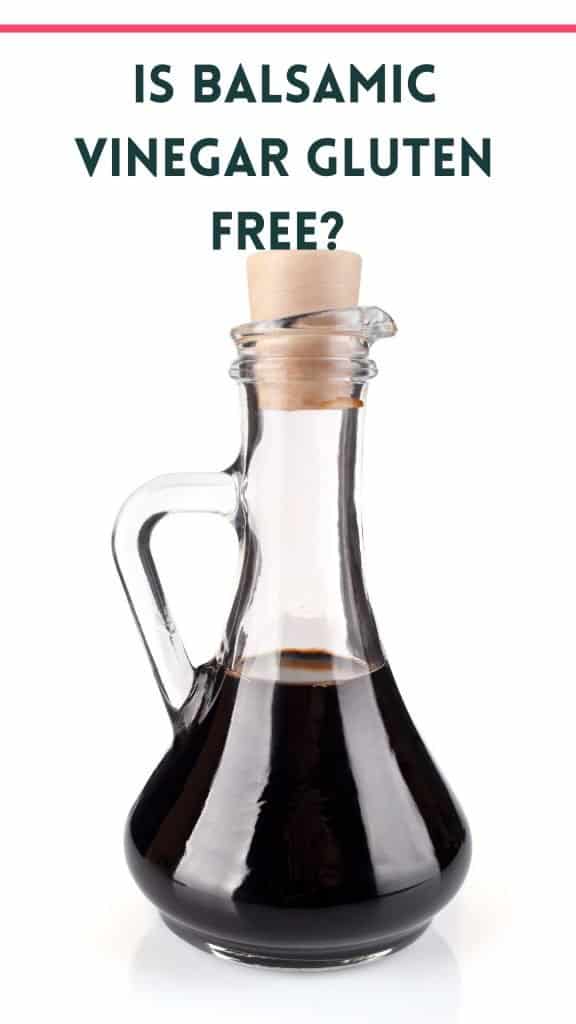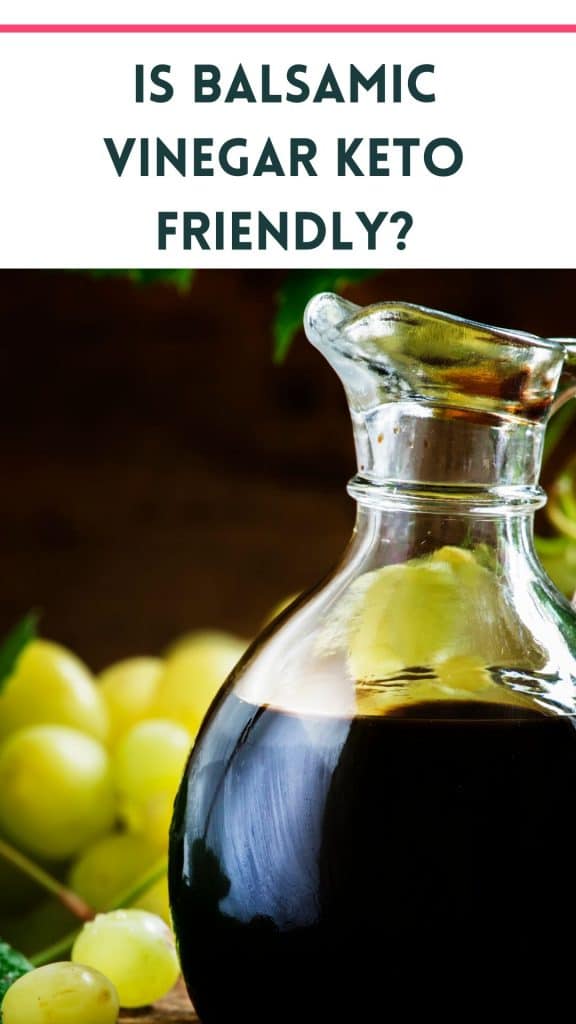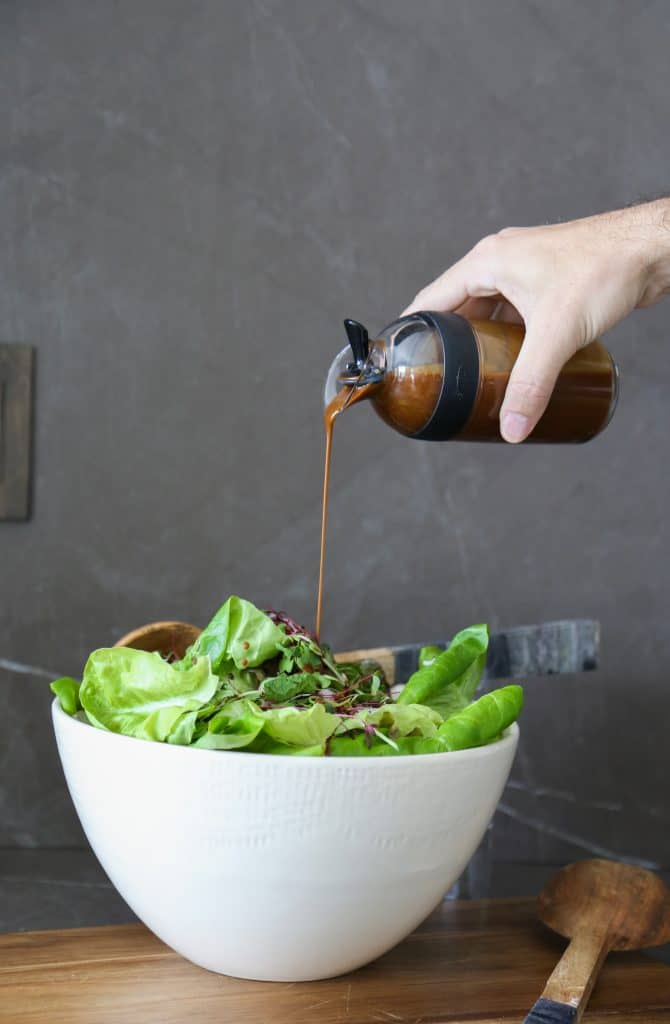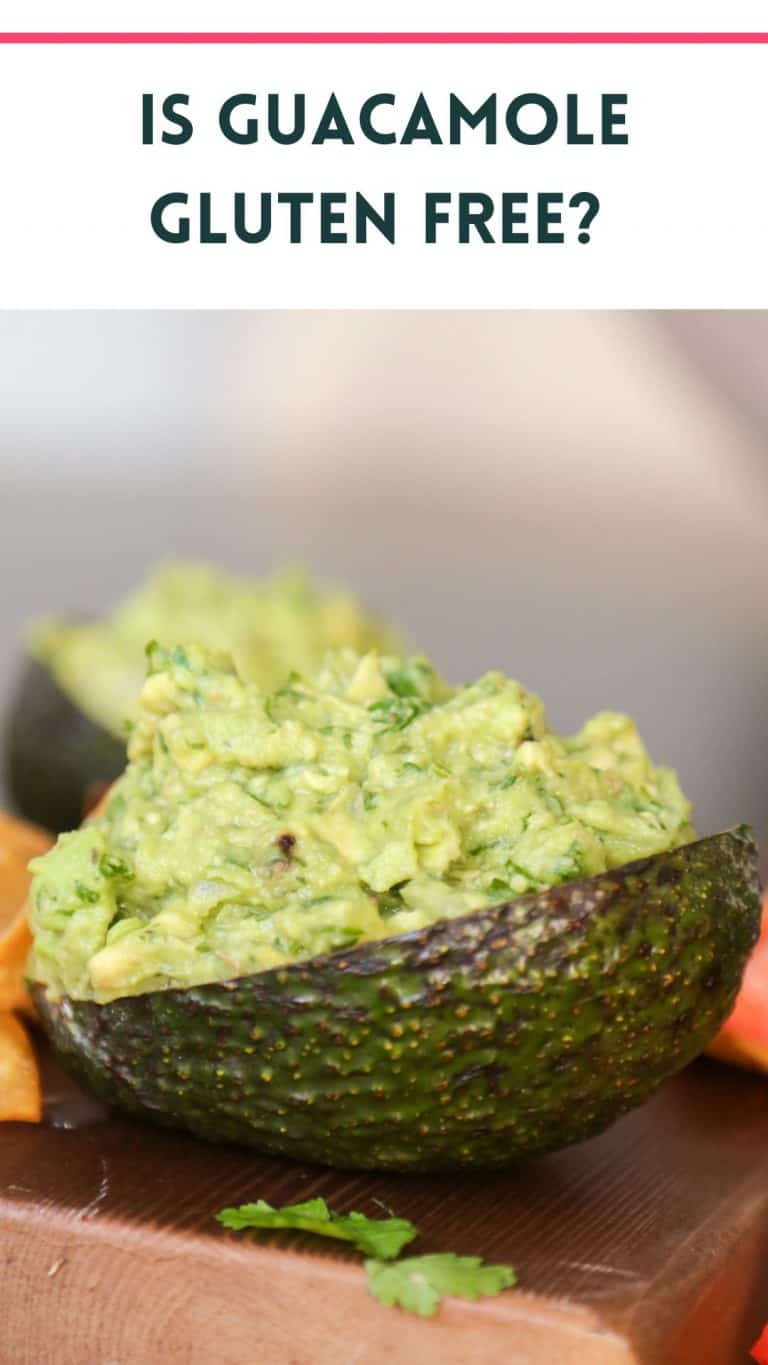Is Balsamic Vinegar Gluten-Free? Yes: (Here’s Why)
Quick Answer: Yes, balsamic vinegar is gluten free because it is derived from unfermented grape juice. Grape juice is the liquid that has been extracted from fresh grapes. Grapes are a type of fruit. Fruits are gluten free because they aren’t derived from wheat or wheat byproducts.

This post may contain affiliate links. As an Amazon Associate I earn from qualifying purchases at no cost to you. See my Affiliate Disclosure to read my policy and more about affiliate links.
Table of Contents
- Is Balsamic Vinegar Gluten Free?
- What Is Balsamic Vinegar?
- How Is Balsamic Vinegar Made?
- What Is Gluten?
- Who Should Follow A Gluten Free Diet?
- Is Balsamic Vinegar and Olive Oil Gluten Free?
- What Brand Of Balsamic Vinegar Is Gluten-Free?
- Are All Vinegars Gluten-Free?
- Is Balsamic Vinegar Keto Friendly?
- Balsamic Vinegar Nutrition Facts
- How To Make Creamy Balsamic Dressing At Home
- How to Make Gluten Free Balsamic Dressing At Home 3 Ways
- My Favorite Homemade Creamy Balsamic Dressing Recipe
- Can Celiacs Have Vinegar?
Is Balsamic Vinegar Gluten Free?
Balsamic vinegar is considered by most people to be naturally gluten free. In it’s purest form it’s true. That balsamic vinegar is gluten free. There is an exception to this widely accepted rule. There are three types of balsamic vinegar out there ranging from pure aged balsamic vinegar without preservatives to commercial grade vinegar that has tons of preservatives in it.
The rule of thumb is that the more expensive the balsamic vinegar is the more pure and naturally gluten free it is. Let’s take a look at the three different types of balsamic vinegar and if they are gluten free or not.
- Traditional Balsamic Vinegar
- Balsamic Vinegar of Modena
- Comercial Grade Balsamic Vinegar (imitation balsamic)
In addition to the three types of balsamic vinegar there is also:
- Balsamic Glaze
- White Balsamic Vinegar
Is Traditional Balsamic Vinegar Gluten Free?
Traditional balsamic vinegar is made in Italy from concentrated fermented grape must also known as grape extract. This fermented grape must is then aged in oak barrels for at least 12 to 25 years, or longer!
Traditionally aged and extracted balsamic vinegar is the purest kind you can get on the market and is how Italians have been making balsamic vinegar for thousands of years. It’s ultra sweet, thick and intensely flavorful. It’s also the most expensive and can cost up to 200 dollars for a bottle.
Since Traditional balsamic vinegar has zero additives in it it’s 100% gluten free. If you are lucky enough to get your hands on a pure bottle of balsamic vinegar don’t be put off by the elaborate label or a lack of gluten free labeling. You can be rest assured that after studying how balsamic vinegar is made that traditional balsamic vinegar is gluten free.
Is Balsamic Vinegar Modena Gluten Free?
What is Balsamic Modena?
Balsamic vinegar de modena is a fancy (Italian) way of saying cheaply mass produced balsamic vinegar. It’s a variety of balsamic vinegar that is a PGI condiement from Italy meaning that it is a geographically protected condiment (It must be made in Italy or Croatia to be labeled modena). The PGI production regulations leave a lot of wiggle room as to how much of the balsamic vinegar needs to be made with actual balsamic vinegar. Anywhere from 20%-90% of the vinegar can be made with wine vinegar instead of real balsamic! These laws also allow comercial producers to use up to 2% of caramel coloring.
Once these ingredients are mixed the balsamic modena must be aged for at least 60 days. If it is aged for three years or more it can be labeled “invecchiato” meaning aged.
PDOTraditional Balsamic Vinegar are different and more restrictive; it must contain only grape must and be aged for at least 12 years.
Is it Gluten Free?
Balsamic vinegar modena may or may not be gluten free depending on what additives are used. Common additives in balsamic modena include corn starch, guar gum, coloring and caramel. These additives are used to intensify the sweetness and thickness of the vinegar. Because of the addition of these ingredients to balsamic vinegar it may or may not be gluten free. It’s best to read the label.
Is Commercial Grade (Imitation) Balsamic Vinegar Gluten Free?
Commercial grade balsamic vinegar (if you can even call it that) is usually gluten free but could have additives that contain gluten. This type of balsamic vinegar isn’t made from grapes at all. Instead it’s usually a combination of cheap wine vinegar, synthetics, sugars, corn flour, corn starch, gums, caramel, artificial coloring.
You should always check the label for any additives that contain wheat in this type of vinegar. See a list of common food additives that contain wheat below.
In my humble opinion, this type of balsamic vinegar isn’t even worth eating. You are better off using a naturally less expensive vinegar like wine and adding sweetener in a dressing to make a palatable balsamic style dressing.
What Is Balsamic Vinegar?
By definition, balsamic vinegar is a dark, sweet, Italian vinegar made from grape juice that has been aged in wooden barrels.
How Is Balsamic Vinegar Made?
Traditional balsamic vinegar is a vinegar made from fermented grape juice that dates back to the Italian middle ages. This special vinegar is traditionally made by boiling down fresh grape juice until it’s concentrated, then it’s fermented and aged in wooden barrels for 12 to 25 plus years.
Commercially produced vinegar is a combination of balasamic vinegar and wine vinegar. Companies cut balsamic with wine vinegar to cut the production time and manufacturing costs down.
That’s why there is such a big dicodamie between balsamic vinegar prices. Some bottles are as cheap as 4 dollars while others can run up to 200 dollars for a tiny portion.
The vinegar is sweet, tart and acidic. It’s traditionally used to make salad dressings, sauces, balsamic glazes and more.
Is Balsamic Glaze Gluten Free?
Balsamic glaze is basically a reduction of balsamic vinegar. If you put balsamic vinegar on the stove and reduce it for 15 minutes it will get thicker and turn into a “glaze.” In theory if the balsamic vinegar is gluten free then the balsamic glaze will also be gluten free!
Is White Balsamic Vinegar Gluten Free?
White balsamic vinegar is balsamic vinegar that is made with white grapes and cooked at lower temperatures to avoid caramelization. THe caramelization is what causes the balsamic vinegar to get darker in color. White balsamic vinegar is gluten free as well. Cheaper white balsamic vinegar is cut with white wine vinegar.
What Is Gluten?
Gluten is a protein that is formed when dough is kneaded to make bread. This protein gives bread it’s structure. Think of the webbing and holes in a good crusty bread that goes “crunch” when you squeeze it. That’s the gluten structure! Gluten also acts as the paste that holds foods together.
An easy way to remember this is to think of the root word in gluten. Which is “glue”. So gluten is like glue. Not only does it hold food together but it also holds food inside of your digestive system. The gluten acts like a thick paste that slows down your body’s natural digestive process.
For some people gluten simply makes them constipated, bloated and sluggish. While other people who have celiac disease have a gluten allergy. People with celiac disease who have a true gluten allergy will have an autoimmune response to eating gluten. Just like any other allergy symptom.
Who Should Follow A Gluten Free Diet?
Any one who suffers from autoimmune disorders, irritable bowel syndrome with constipation, celiac, chronic stomach discomfort or bloating should limit gluten. Depending on how bad your symptoms are wold dictate how strictly you need to avoid gluten.
If you notice that gluten makes you a little bloated it would be good to limit it but you don’t have to get rid of it entirely. Chances are that trace amounts of gluten (like the small amount of gluten that could be present in cheap balsamic vinegar) will not bother you.
If you have celiac disease that is a real gluten allergy and you should avoid even trace amounts of gluten. For those of you with celiac disease you should always check labels and avoid foods that have been cross contaminated with gluten. Like Butter commonly gets cross contaminated by gluten when a bread knife is dipped from the butter onto wheat and back.
Is Balsamic Vinegar and Olive Oil Gluten Free?
Yes! Generally speaking balsamic vinegar and olive oil combined are gluten free! Balsamic vinegar is naturally derived from grape must while olive oil is extracted from olives. Both of these (grapes and olives) are plant based sources void of any wheat what-so-ever.
However I’m talking about good quality olive oil and balsamic vinegar here. IF you are using cheap commercial grade balsamic vinegar and oil there is a small chance that it could contain small amounts of gluten. Always check the label to be sure. But
What Brand Of Balsamic Vinegar Is Gluten-Free?
- Tastefully Simple Aged Balsamic Vinegar of Modena, 8.5 Fluid Ounce
- Non-GMO Balsamic Glaze – De La Rosa
- Thrive Market Balsamic Vinegar
- Star Balsamic Vinegar
- Primal Kitchen Balsamic Vinegar
- Alessi Balsamic Vinegar
- 365 Balsamic Vinegar
Is Heinz Balsamic Vinegar Gluten Free?
Heinz balsamic vinegar of modena is gluten free! The only ingredients in Heinz balsamic vinegar are potassium metabisulfite and balsamic vinegar. potassium metabisulfite is gluten free and added to the balsamic vinegar to preserve the color.
Is Bertolli Balsamic Vinegar Gluten Free?
Bertolli balsamic vinegar is gluten free because the website states that all of their vinegars are gluten free. It’s also labeled gluten free.
Are All Vinegars Gluten-Free?
No, most vinegars are gluten free but not all of them are. Some types of vinegar are extracted from wheat containing sources. For example wine vinegar, balsamic vinegar and apple cider vinegar are gluten free. However non-distilled vinegars made from grains that come from wheat are not gluten free. These grains would include wheat, barely, malt vinegar and straight wheat.
Is Balsamic Vinegar Keto Friendly?

The answer is that it depends. Balsamic vinegar is the only kind of vinegar that has carbs and sugar in it. So of all of the vinegars out there it is the least keto friendly. However, eating 1-2 tablespoons of balsamic vinegar will only provide you with 4 grams of carbs on average. Although the higher the quality the balsamic vinegar is the more carbohydrates and sugar it has.
So the cheaper less sweet balsamic vinegar is more keto friendly. Cheap balsamic vinegar is also cut with red wine vinegar which lowers the grams of carbs in it. In moderation balsamic vinegar is good for a keto diet. In fact, a little vinegar will satisfy your sweet tooth which can prevent you from binging on carbs and blowing yourself out of ketosis.
Balsamic Vinegar Nutrition Facts
One-tablespoon serving of balsamic vinegar
- Calories: 5
- Protein: 0 grams
- Fat: 0 grams
- Carbohydrates: 2 grams
- Fiber: 0 grams
- Sugar: 2 grams
How To Make Creamy Balsamic Dressing At Home
The best way to make creamy balsamic dressing at home is in a blender. You could also use a mason jar or a bowl and a whisk. Below I go over all three ways you can make homemade balsamic vinaigrette.
What Ingredients You Need To Make Balsamic Dressing
There are tons of different balsamic dressing recipes out there but they are all variations of a combination of oil, sugar, herbs and vinegar. Here are the ingredients for my favorite balsamic vinaigrette dressing.
How to Make Gluten Free Balsamic Dressing At Home 3 Ways
In A Mason Jar
To make a thinner Balsamic vinaigrette in a mason jar all you have to do is combine all of the ingredients into the jar. Next, shake the jar vigorously until all of the ingredients are combined. Pour the dressing onto the salad right away.
This method will create a temporary emulsion. This means that the oil and vinegar will separate and that the solids will sink to the bottom of the jar. Before using the dressing you always have to shake it to mix it up.
In a Blender
If you want a creamy balsamic dressing with a permanent emulsion the best way is to use a blender. A permanent emulsion means that the dressing will never separate. So not only will it be thick and creamy, but the flavor will be more concentrated.
In A Bowl
One of my favorite ways to make balsamic dressing is to put all of the ingredients into a medium sized mixing bowl and then use a whisk to vigorously mix it until the vinegar and oil emulsify.
My Favorite Homemade Creamy Balsamic Dressing Recipe
This intensely flavored gluten free creamy balsamic dressing recipe takes only 5 minutes to throw together in a blender. It’s made with olive oil, balsamic vinegar, spices, garlic, agave and mustard.
And is the perfect balsamic dressing for drizzling over salads, pasta, seafood and more! You’ll never believe that you can make such a thick dressing with vegan and gluten free ingredients! That’s right, you don’t need any dairy for this recipe. So hold the mayo!

Can Celiacs Have Vinegar?
Yes Celiacs can have vinegar as long as it is not derived from wheat, barley, rye or malt vinegar. All other types of vinegar including balsamic vinegar, wine vinegar and apple cider vinegar, rice vinegar are naturally gluten free.
Yes mayonnaise is naturally gluten free since it’s made from eggs, oil and
Yes the original Worcester sauce has gluten in it because it has barley malt. Barley is a form of wheat and therefore has gluten. There are other gluten-free brands of Worcester sauce out there. It’s important to check the labels for ingredients that say wheat or only buy Worcester sauce that is labeled gluten-free.
Is balsamic vinegar gluten free google web story!

FREE 7 Day Gluten Free Meal Plan
A meal plan designed to jump start whole body healing and support digestive health……
…And get the latest recipes!






